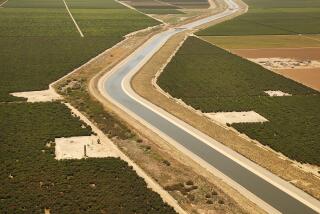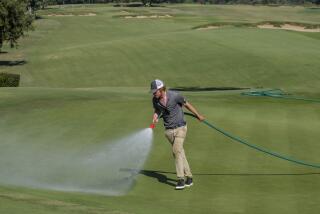Cutting back as levels fall
Officials of the small Mendocino County town of Willits looked at their two municipal reservoirs last week, did some calculating and realized they had enough water to last only 100 days. It was time to adopt the toughest rationing measures they could.
The 5,000 residents of this former lumber town on the edge of redwood country are now on a crash water diet. A family of four isn’t supposed to use more than 150 gallons a day. Outdoor watering, car washing and hosing down pavement are banned. Businesses have been ordered to cut water use 35%.
“The more we looked at the data, the more we realized the situation is bleak,” Willits City Manager Adrienne Moore said.
As the winter progresses with no break from last year’s parched conditions, concern is mounting that California may be headed for a replay of the big drought of the late 1980s through the early 1990s, or even worse, 1977.
The snow and rain could still come. Only about half the rainy season is over. But if monotonously sunny weather continues to curse the state, the pain of water shortages will spread, albeit unevenly.
“A lot of the smaller systems are going to be really hurting because they really don’t have a lot of carry-over” of supplies from one year to the next, said Maury Roos, the state’s chief hydrologist.
Water managers in Southern California, on the other hand, say they have enough reserves to get the state’s most populous region through the year and even into 2015 without rationing. San Francisco’s water stores are also in decent shape.
The huge Imperial Irrigation District in Imperial County -- one of the nation’s major sources of winter lettuce and vegetables -- will get its regular Colorado River deliveries this year. And growers with the most senior water rights on the Sacramento and San Joaquin rivers won’t suffer more than a 25% cut in irrigation deliveries.
The story will be different for ranchers, communities that depend on local surface supplies and many San Joaquin Valley growers, particularly on the valley’s south and west sides.
“I shudder to think if rain doesn’t come,” said Carre Brown, a supervisor in Mendocino County, which last week declared a drought emergency. “All our reservoirs are very, very low.”
Willits officials plan to apply for emergency state funding to help cover the estimated $850,000 cost of developing alternative supplies. Moore said a portable treatment system could be used to purify well water normally used to irrigate athletic fields. The town may also drill new wells or tap a local recreational lake.
Residents significantly cut water use even before the rationing went into effect.
“This is an area where people are good at conservation, so they’re geared for that,” Moore said.
But there’s one local faction that could be a problem.
“Quite honestly, the elephant in the room in several different ways in this matter is the marijuana industry,” she said. “They are heavy water users.”
If pot growers don’t cut back, they will be getting a knock on the door from local enforcement officers, who “will address the situation,” she added.
Although 2013 was California’s driest calendar year in 119 years of records, from a hydrological and water supply perspective, the state is just now tipping into drought. Gov. Jerry Brown has not yet issued an official drought proclamation but said Monday that he soon will. “It’s really serious,” Brown said, noting that 2014 could be California’s third dry year in a row. “In many ways it’s a mega-drought.”
A drought declaration could speed up state assistance to local government, cut red tape for water transfers and set the stage for the State Water Resources Control Board to ease environmental requirements for dam releases.
Thanks to storms in late 2012, the last water year -- a period that ended Sept. 30 and covered all of the last rainy season -- was far from the worst. It ranks as the 29th driest water year on record, according to the California Climate Tracker at the Western Regional Climate Center in Reno.
Storage in most major reservoirs is well below average for the date and dropping when it should be rising. But several reservoirs, including Shasta and Lake Oroville, the state’s two biggest, had less water in them in January of 2009 and 1991. “We’re pretty low but there were worse” years, Roos said.
There’s always a chance the weather could change and the stubborn, storm-blocking high pressure ridge parked off the West Coast could finally go away.
In early 2009, the state echoed with ominous drought warnings. Then a series of February storms fattened the snowpack and filled rain gauges. A “Miracle March” in 1991 brought triple the month’s normal precipitation.
Some of the grimmest measurements this year are from Folsom Lake on the American River northeast of Sacramento. The reservoir is only 18% full, a near record low that has gotten the attention of places not known for their thrifty water ways.
“Folsom Lake -- it’s pretty obvious there’s a problem,” said Shauna Lorance, general manager of the San Juan Water District, which delivers Folsom water to Sacramento suburbs where big landscaped lots and irrigated horse pastures drive the district’s per capita water use to about 369 gallons a day. That is three times the rate in Los Angeles.
The district has asked customers to stop all outdoor watering and, if it remains dry, Lorance said the request probably would turn into an order.
In nearby Sacramento, which draws some supplies from the American River, the City Council on Tuesday approved mandatory rationing. “We’re not going to have Gestapo-type tactics here, but we’re asking all water users to reduce their usage by 20%,” City Manager John Shirey said. “For an average residential customer, we think that’s entirely attainable.”
Situated on two rivers and toasted by Central Valley summers, California’s capital city has traditionally been something of a water hog. It is only now installing water meters and about half of Sacramento’s residences still don’t have them, meaning they pay a flat rate for unlimited water.
Still, water use has dropped in recent years and Shirey said rainless seasons like this will further drive home the need to conserve -- all the time.
“With climate change occurring we have to assume that we could see long-term shortages of water in California, “ he said. “We just have to change, I think, the mind-set here and everywhere -- we’re going to have less water to rely on.”
In the meantime, the Catholic bishops of California have asked the faithful to pray for rain.
--
More to Read
Sign up for Essential California
The most important California stories and recommendations in your inbox every morning.
You may occasionally receive promotional content from the Los Angeles Times.










